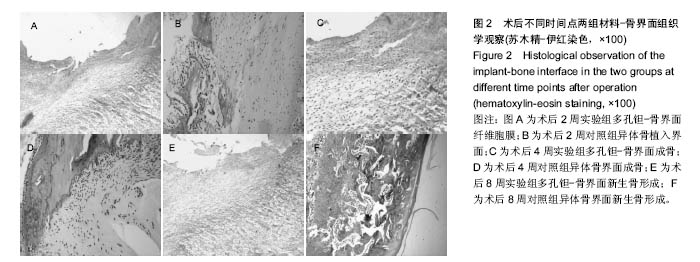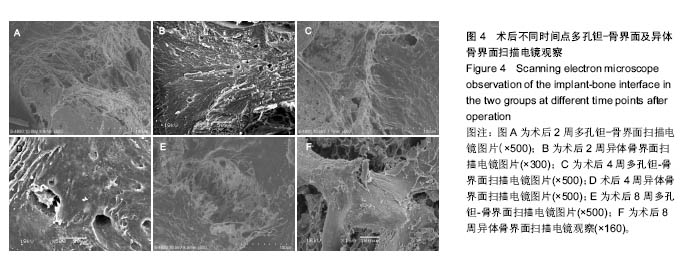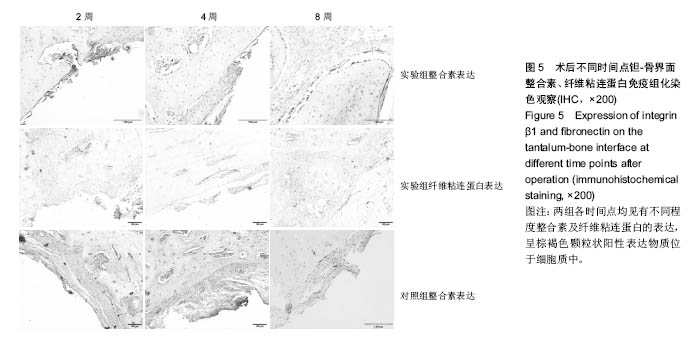中国组织工程研究 ›› 2017, Vol. 21 ›› Issue (18): 2789-2795.doi: 10.3969/j.issn.2095-4344.2017.18.001
• 组织工程骨及软骨材料 tissue-engineered bone and cartilage materials • 下一篇
新型骨植入材料多孔钽-骨结合界面成骨以及相关成骨因子的表达及意义
赖振权1,崔逸爽1,陈 超2,周国龙1,潘祥宇1,王 茜3,甘洪全4,王志强4,李琪佳1
- 华北理工大学,1医学实验中心,3基础医学院,河北省唐山市 063000;2河北省遵化市人民医院病理科,河北省遵化市 064200;4华北理工大学附属医院骨科,河北省唐山市 063000
Expression and significance of osteogenic genes on porous tantalum-bone interface during osteogenesis
Lai Zhen-quan1, Cui Yi-shuang1, Chen Chao2, Zhou Guo-long1, Pan Xiang-yu1, Wang Qian3, Gan Hong-quan4, Wang Zhi-qiang4, Li Qi-jia1
- 1Medicine Experimental Center of North China University of Science and Technology, Tangshan 063000, Hebei Province, China; 2Department of Pathology, Zunhua People’s Hospital, Zunhua 064200, Hebei Province, China; 3Basic Medical College of North China University of Science and Technology, Tangshan 063000, Hebei Province, China; 4Department of Orthopaedics, Affiliated Hospital of North China University of Science and Technology, Tangshan 063000, Hebei Province, China
摘要:
文章快速阅读:
.jpg)
文题释义:
多孔钽:是一种新型较理想的骨移植材料,在20世纪末由美国Zimmer公司开发。多孔钽具有较高的成孔率,表面摩擦系数大,弹性模量与人体骨质接近,延展性好,抗疲劳及耐磨性强,抗腐蚀性且与组织液无反应,可以加快骨愈合过程。在骨内生性生长的同时还能够长期支撑骨的生理性负荷。
国产多孔钽性能参数:国产多孔钽选用纯钽粉经粉末冶金浇注工艺制备,纯度高(99.8%),延展性高于9.2%,孔隙率65%-85%,孔径达到400-600 μm。其力学参数优于其他同类产品,抗压强度200 MPa,弯曲强度170 MPa,弹性模量2.1 GPa,而且可以通过孔隙度和孔隙结构调整,使产品更接近人体骨。
摘要
背景:具有自主知识产权的国产多孔钽材料具有无毒性及良好的生物相容性,前期体内外实验研究得出结论:国产多孔钽无毒性,具有良好的生物相容性,具有促成骨作用。此次实验是多孔钽-骨界面成骨机制的探讨。
目的:观察多孔钽兔股骨植入后钽-骨结合界面成骨形态特点及成骨相关因子整合素β1及纤维粘连蛋白的表达,探讨多孔钽骨内植入钽-骨界面骨整合的生物学机制。
方法:实验采用自身对照方法,取日本大耳白兔制备双侧股骨髁骨缺损模型,同一动物左侧股骨内植入多孔钽棒为实验组,右侧股骨内植入异体骨为对照组。术后2,4,8 周于骨缺损部位取材,石蜡切片、硬组织切片光镜观察多孔钽与宿主骨交界处成骨形态特点;扫描电镜观察多孔钽-骨界面成骨特征;免疫组织化学检测整合素β1及纤维粘连蛋白的表达。
结果与结论:①多孔钽棒植入后与宿主骨结合紧密。石蜡切片苏木精-伊红染色结果显示:界面纤维膜早期疏松、较厚,晚期致密较薄,界面出现片状成骨;②硬组织切片观察:2周时钽-骨界面已出现新生骨及小血管并向孔隙内生长;4、8周时钽-宿主骨界面新生骨增多并与宿主骨连接成片,骨小梁成熟;③扫描电镜下可见成骨细胞在多孔钽表面及孔隙内生长,晚期骨质成熟并见板层骨;④免疫组化结果显示:多孔钽骨植入2周时实验组整合素 β1的表达显著低于对照组(P < 0.05);而纤维粘连蛋白的表达在两组之间比较差异均无显著性意义(P > 0.05);整合素及纤维粘连蛋白的表达在2,4,8周时均呈递减趋势;⑤结论:多孔钽有利于成骨细胞在其表面及孔隙内黏附,整合素β1及纤维粘连蛋白在成骨初期钽-骨界面表达增高,可能对早期成骨起促进作用,而在骨成熟期表达则降低,有利于骨整合及改建。
中图分类号:






.jpg)